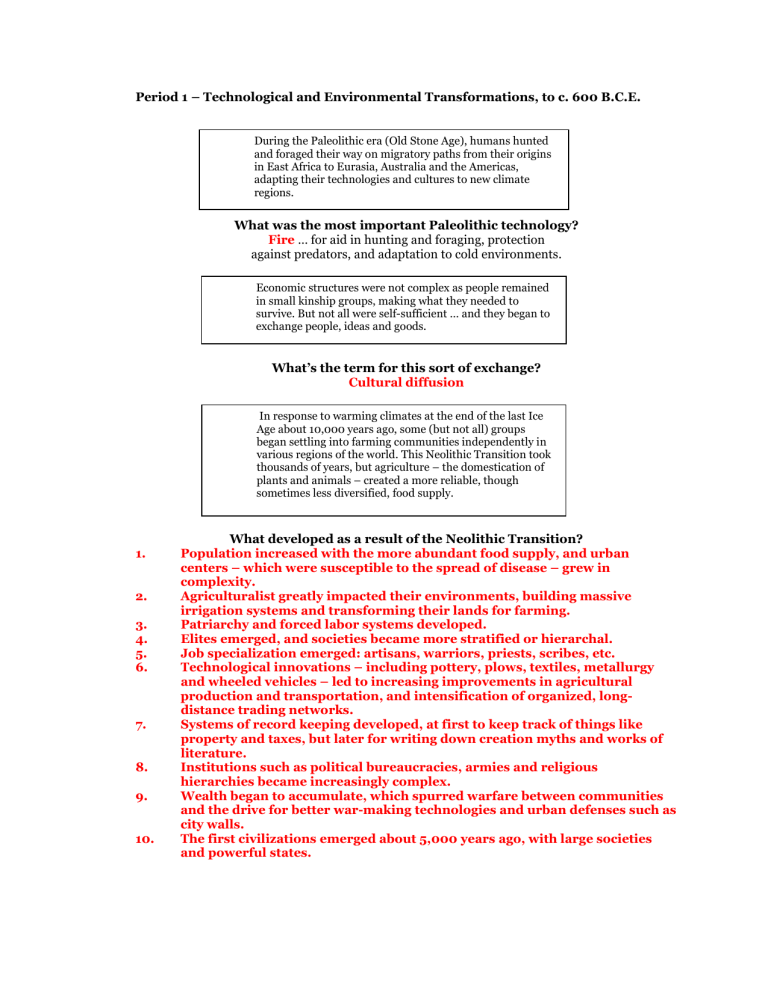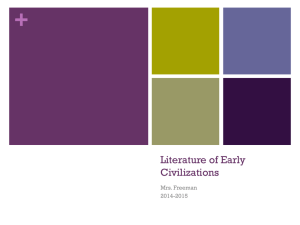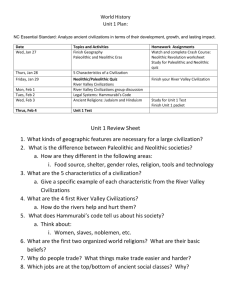Period 1 – Technological and Environmental Transformations, to c

1.
8.
9.
7.
5.
6.
2.
3.
4.
Period 1 – Technological and Environmental Transformations, to c. 600 B.C.E.
During the Paleolithic era (Old Stone Age), humans hunted and foraged their way on migratory paths from their origins in East Africa to Eurasia, Australia and the Americas, adapting their technologies and cultures to new climate regions.
What was the most important Paleolithic technology?
Fire … for aid in hunting and foraging, protection against predators, and adaptation to cold environments.
Economic structures were not complex as people remained in small kinship groups, making what they needed to survive. But not all were self-sufficient … and they began to exchange people, ideas and goods.
What’s the term for this sort of exchange?
Cultural diffusion
In response to warming climates at the end of the last Ice
Age about 10,000 years ago, some (but not all) groups began settling into farming communities independently in various regions of the world. This Neolithic Transition took thousands of years, but agriculture – the domestication of plants and animals – created a more reliable, though sometimes less diversified, food supply.
10.
What developed as a result of the Neolithic Transition?
Population increased with the more abundant food supply, and urban centers – which were susceptible to the spread of disease – grew in complexity.
Agriculturalist greatly impacted their environments, building massive irrigation systems and transforming their lands for farming.
Patriarchy and forced labor systems developed.
Elites emerged, and societies became more stratified or hierarchal.
Job specialization emerged: artisans, warriors, priests, scribes, etc.
Technological innovations – including pottery, plows, textiles, metallurgy and wheeled vehicles – led to increasing improvements in agricultural production and transportation, and intensification of organized, longdistance trading networks.
Systems of record keeping developed, at first to keep track of things like property and taxes, but later for writing down creation myths and works of literature.
Institutions such as political bureaucracies, armies and religious hierarchies became increasingly complex.
Wealth began to accumulate, which spurred warfare between communities and the drive for better war-making technologies and urban defenses such as city walls.
The first civilizations emerged about 5,000 years ago, with large societies and powerful states.
Core and foundational civilizations emerged in six different regions of the world.
1.
2.
3.
4.
5.
6.
Name and locate them.
Mesopotamia in the Tigris and Euphrates River Valleys
Egypt in the Nile River Valley
Mohenjo-Daro and Harappa in the Indus River Valley
Shang in the Yellow River Valley
Olmecs in Mesoamerica
Chavin in Andean South America
Not all peoples became agriculturalists. Some, who lived in areas not well-suited for intensive farming, such as the grasslands or steppes of Central Asia, domesticated animals but did not cultivate crops such as wheat or barley. Instead, they lived off their herds and grazed with the seasons.
What’s the name for these people?
Pastoralists, or pastoral nomads
Pastoralists were often the developers and disseminators of new weapons and modes of transportation that transformed warfare in agrarian civilizations. They relied heavily on the single greatest war-making machine in history up until modern times.
What’s the name for that war-making machine? the horse
Political and religious elites in civilizations promoted arts and artisanship, such as sculpture, painting, wall decorations and elaborate weaving. They also devoted huge resources to urban planning and monumental architecture.
4.
1.
2.
3.
Give some examples of urban planning and monumental architecture.
The sewage and water systems of the Harappan civilization in the Indus
River Valley
The ziggurats of Mesopotamia
The pyramids of Egypt
The colossal heads of the Olmecs
Most early religions were animistic and many embraced animal or even human sacrifice. Some new religions emerged, however, that continued to have a strong influence on later periods. Most prominent among these new religious beliefs were the Vedic religion, Hebrew monotheism and
Zorastrianism.
View PowerPoints 4 (slides 22-25 and 35), 5 (slides 14-16) and 7 (slides 5-6 and 13).
What do you think were the major religions that were inspired by these early beliefs and arose in the following period of history (c. 600 B.C.E. to c. 600 C.E.)?
Judaism, Christianity and Hinduism







